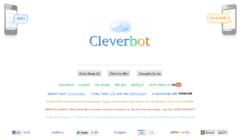Cleverbot
|
Screenshot
| |
Type of site | Chatterbot |
|---|---|
| Created by | Rollo Carpenter |
| Website |
www |
| Alexa rank |
|
| Registration | None |
| Current status | Active |
Cleverbot is a web application that uses an artificial intelligence algorithm to have conversations with humans. It was created by the British AI scientist Rollo Carpenter. It went online under the name of Jabberwacky in 1996. In its first decade, Cleverbot held several thousand conversations with Carpenter and his associates. Since launching on the web, the number of conversations held has exceeded 200 million. Besides the web application, Cleverbot is also available as an iOS, Android, and Windows Phone app.[2]
Operation
Unlike other chatterbots, Cleverbot's responses are not programmed. Instead, it "learns" from human input; Humans type into the box below the Cleverbot logo and the system finds all keywords or an exact phrase matching the input. After searching through its saved conversations, it responds to the input by finding how a human responded to that input when it was asked, in part or in full, by Cleverbot.[3][4]
Cleverbot participated in a formal Turing test at the 2011 Techniche festival at the Indian Institute of Technology Guwahati on September 3, 2011. Out of the 334 votes cast, Cleverbot was judged to be 59.3% human, compared to the rating of 63.3% human achieved by human participants. A score of 50.05% or higher is often considered to be a passing grade.[5] The software running for the event had to handle just 1 or 2 simultaneous requests, whereas online Cleverbot is usually talking to around 80,000 people at once.
Developments
Cleverbot is constantly "learning", growing in data size at a rate of 4 to 7 million interactions per second. Updates to the software have been mostly behind the scenes. In 2014, Cleverbot was upgraded to use GPU serving techniques.[6] The program chooses how to respond to users fuzzily, the whole of the conversation being compared to the millions that have taken place before. Cleverbot now uses over 279 million interactions, about 3-4% of the data it has already accumulated. The developers of Cleverbot are attempting to build a new version using machine learning techniques. [7]
A significant part of the engine behind Cleverbot, and an API for access to serving, has been made available to developers in the form of Cleverscript. A service for directly accessing Cleverbot has been made available to developers in the form of Cleverbot.io.
An app that uses the Cleverscript engine to play a game of 20 Questions, has been launched under the name Clevernator. Unlike other such games, the player asks the questions and it is the role of the AI to understand, and answer factually. An app that allows owners to create and talk to their own small Cleverbot-like AI has been launched, called Cleverme! for Apple products.[8]
See also
References
- ↑ "Cleverbot.com Site Info". Alexa Internet. Retrieved 2014-04-01.
- ↑ "Cleverbot". Cleverbot.com. Retrieved 14 January 2013.
- ↑ Saenz, Aaron (2010-01-13). "Cleverbot Chat Engine Is Learning From The Internet To Talk Like A Human". Singularity Hub. Retrieved 2011-06-06.
- ↑ "Rollo Carpenter". Technische. Indian Institute of Technology Guwahati. Retrieved 13 November 2011.
- ↑ Aron, Jacob (6 September 2011). "Software tricks people into thinking it is human". New Scientist. Retrieved 13 November 2011.
- ↑ "Parallel Processing on Graphics Cards - Existor.com - Cleverbot". Existor.com. 2014-02-05. Retrieved 2014-06-09.
- ↑ "Cleverbot Data for Machine Learning – Existor". www.existor.com. Retrieved 2016-11-30.
- ↑ "Cleverme! on the App Store on iTunes". iTunes. Retrieved 24 March 2014.
